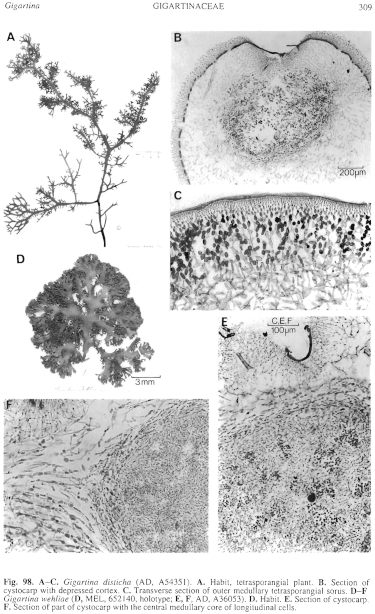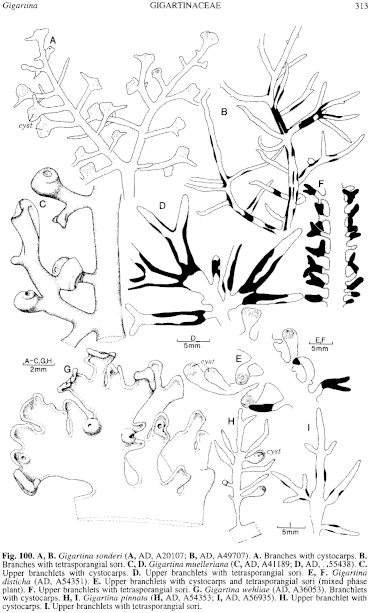|
|
|
|
|
|||||||||||
|
Electronic Flora of South Australia Species Fact Sheet
Phylum Rhodophyta – Class Florideophyceae – Order Gigartinales – Family Gigartinaceae
Selected citations: J. Agardh 1851: 269; 1876: 194; 1899: 10. Harvey 1863: pl. 297. Kützing 1849: 750; 1869: 7, pl. 18a, b.
Thallus (Fig. 98A) medium to dark red, fading to yellow-red, erect and moderately rigid, drying cartilaginous, 20–30 cm high, with one to several fronds. Fronds subdichotomous (occasionally laterally branched), often subpinnate above, axes compressed, 3–6 (–8) mm broad, with a terete stipe, above bearing distichous, short, fertile, laterals, alternate to opposite, 3–10 mm long and (0.5–) 1–1.5 mm in diameter, with a terete lower part, terete or slightly compressed above, varying from simple to 2 or 3 times furcate, apices rounded to subacute. Holdfast discoid, 1–6 (–10) mm across; epilithic. Structure of a cortex of anticlinal, subdichotomous filaments, outer cells 1–2 µm in diameter and L/D 2–4, and a medulla of anastomosing filaments, slender near apices, soon becoming 5–10 (–20) µm thick.
Reproduction: Sexual thalli monoecious. Carpogonial branches 3-celled, borne on an inner cortical (supporting) cell, occurring as scattered groups near the apex of the short laterals. Cystocarps (Fig. 100E) subterminal in clavate branchlets, usually single, 1–1.5 mm across, with a distinct cortical depression, without involucral ramuli, with diffuse enveloping tissue (with inner cells often connected to gonimoblast filaments but without transverse filaments) and the carposporophyte (Fig. 98B) with a filamentous matrix, numerous scattered larger cells, and clusters of ovoid carposporangia 14–18 µm in diameter, liberated by cortical disintegration. Spermatangial sori inconspicuous, adjacent to developing cystocarps, with elongate spermatangia cut off from surface cortical cells and each producing a single ovoid spermatium about 1 µm in diameter.
Tetrasporangial sori (Fig. 100F) surrounding the upper parts of the lateral branchlets, 2–4 mm long, tetrasporangia (Fig. 98C) transformed primarily from outer medullary cells in rows of 3–6, with some cut off laterally, ovoid, 25–30 µm in diameter, cruciately divided.
Mixed phase plants (Fig. 100E) sometimes occur, with cystocarps and tetrasporangia on the same plant.
Type from Busselton, W. Aust. (Preiss); holotype in Herb. Sonder, MEL, 652078 (the only Preiss specimen in MEL).
Selected specimens: Fremantle, W. Aust. (MEL, 652084). Halls Head, Mandurah, W. Aust., drift (Edyvane, 22.v.1983; AD, A54354). Eyre, W. Aust., drift (Woelkerling, 22.xi.1968; AD, A34233). Elliston, S. Aust., 11 m deep in bay (Shepherd, 19.iv.1970; AD, A35864) and 5–10 m deep (Shepherd & Turner, 1.v.1982; AD, A53146). Redbanks, Whalers Way (Port Lincoln), S. Aust., 4–6 m deep (Hone, 23.v.1990; AD, A60403). Waller Shoals, off Second I., Pondalowie Bay, Yorke Pen., S. Aust., 20 m deep (Edyvane, 1.iv.1983; AD, A54351 -"Marine Algae of so uthern Australia" No. 357, and 2.iv.1983; AD, A54353). Middle R., Kangaroo I., S. Aust., drift (Womersley, 21.i.1948; AD, A6776). Vivonne Bay, Kangaroo I., S. Aust. drift (Womersley, 2.i.1949; AD, A10608). Encounter Bay, S. Aust. (Cleland; AD, A3701). Cape Jaffa, S. Aust., drift (Womersley, 31.viii.1949; AD, A10856). Robe, S. Aust. (Macklin; AD, A854). Glenelg R. mouth, Vic. (Muir, Jan. 1950; AD, A15710). E of Fitzroy R. mouth, Portland Bay, Vic., drift (Beauglehole, 19.iv.1959; MEL, 652074).
Distribution: Fremantle, W. Aust. (Harvey) to the Fitzroy R. mouth, Vic., usually in the deeper sublittoral on rough-water coasts.
Taxonomic notes: G. disticha is a distinctive species, characterised by the basically subdichotomous (to lateral) fronds with terete to slightly compressed branches mostly 3–6 mm broad, bearing short distichous laterals which become fertile. It is found mainly in deeper water (10–20 m) on rough-water coasts and is of western distribution but extends just into Victoria.
G. disticha has been reported incorrectly from New Zealand (see Chapman 1979, p. 408). G. divaricata Harvey & Hooker (1845, p. 187) is somewhat similar but the axes are less compressed and older parts are more profusely and less distichously branched.
References:
AGARDH, J.G. (1851). Species Genera et Ordines Algarum. Vol. 2, Part 1, 1–336 + index. (Gleerup: Lund.)
AGARDH, J.G. (1876). Species Genera et Ordines Algarum. Vol. 3, Part 1 - Epicrisis systematis Floridearum, pp. i-vii, 1–724. (Weigel: Leipzig.)
AGARDH, J.G. (1899). Analecta Algologica. Cont. V. Acta Univ. lund. 35, 1–160, Plates 1–3.
CHAPMAN, V.J. (1979). The marine algae of New Zealand. Part DI Rhodophyceae. Issue 4: Gigartinales. (Cramer: Germany.)
HARVEY, W.H. & HOOKER, J.D. (1845). Algae. In Hooker, J.D., The Botany of the Antarctic Voyage. I. Flora Antarctica. Part I, pp. 175–193, Plates 69–78.
HARVEY, W.H. (1863). Phycologia Australica. Vol. 5, Plates 241–300, synop., pp. i-lxxiii. (Reeve: London.)
KÜTZING, F.T. (1849). Species Algarum. (Leipzig.)
KÜTZING, F.T. (1869). Tabulae Phycologicae. Vol. 19. (Nordhausen.)
SONDER, O.G. (1845). Nova Algarum genera et species, quas in itinere ad oras occidentales Novae Hollandiae, collegit L. Preiss, Ph.Dr. Bot. Zeit. 3, 49–57.
SONDER, O.W. (1848). Algae. In Lehmann, C., Plantae Preissianae. Vol. 2, pp. 161–195. (Hamburg.)
The Marine Benthic Flora of Southern Australia Part IIIA complete list of references.
Publication:
Womersley, H.B.S. (14 January, 1994)
The Marine Benthic Flora of Southern Australia
Rhodophyta. Part IIIA, Bangiophyceae and Florideophyceae (to Gigartinales)
Reproduced with permission from The Marine Benthic Flora of Southern Australia Part IIIA 1994, by H.B.S. Womersley. Australian Biological Resources Study, Canberra. Copyright Commonwealth of Australia.
Illustrations in Womersley Part IIIA, 1994: FIGS 98 A–C, 100E, F.

Figure 98 enlarge
Fig. 98. A–C. Gigartina disticha (AD, A54351). A. Habit, tetrasporangial plant. B. Section of cystocarp with depressed cortex. C. Transverse section of outer medullary tetrasporangial sorus. D–F. Gigartina wehliae (D, MEL, 652140, holotype; E, F, AD, A36053). D. Habit. E. Section of cystocarp. F. Section of part of cystocarp with the central medullary core of longitudinal cells.

Figure 100 enlarge
Fig. 100. A, B. Gigartina sonderi (A, AD, A20107; B, AD, A49707). A. Branches with cystocarps. B. Branches with tetrasporangial sori. C, D. Gigartina muelleriana (C, AD, A41189; D, AD, .55438). C. Upper branchlets with cystocarps. D. Upper branchlets with tetrasporangial sori. E, F. Gigartina disticha (AD, A54351). E. Upper branchlets with cystocarps and tetrasporangial sori (mixed phase plant). F. Upper branchlets with tetrasporangial sori. G. Gigartina wehliae (AD, A36053). Branchlets with cystocarps. H, L Gigartina pinnata (H, AD, A54353; I, AD, A56935). H. Upper branchlet with cystocarps. I. Upper branchlets with tetrasporangial sori.

|
Email Contact: State Herbarium of South Australia |

|